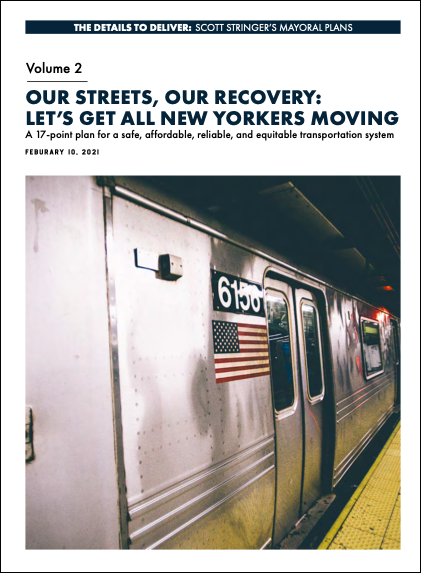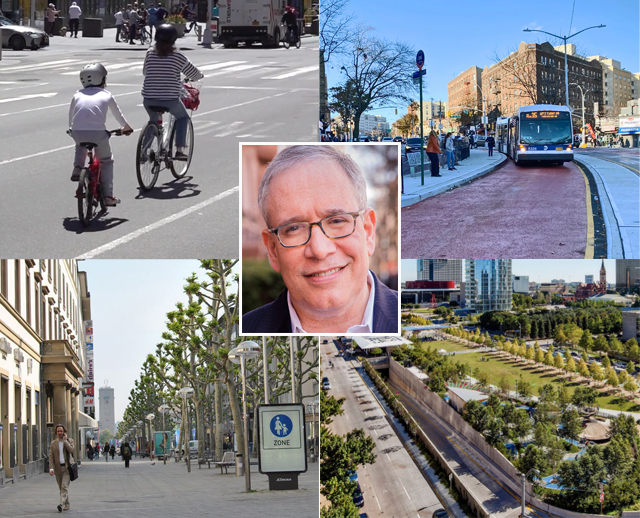This is the third in a series of deep dives into the mayoral candidates’ positions on transportation issues affecting the city. So far, we’ve looked at plans by Shaun Donovan and Kathryn Garcia, and analyzed them, as you can see by clicking the links, in lengthy, detailed form. But too many candidates are silent on this key lifestyle, climate and equity issue (the websites of Maya Wiley, Ray McGuire, Dianne Morales, Loree Sutton, for example, don’t specifically address transportation). We encourage all candidates to participate in our coverage by emailing Streetsblog Editor Gersh Kuntzman at gersh@streetsblog.org.
If elected mayor, Scott Stringer promises to build more bike lanes, pedestrianize more of the city, completely reform parking rules, massively reduce the issuance of parking placards to city employees, boost transit (especially buses!) and reduce the ability of community boards to block or delay crucial street safety projects.
It's all part of Stringer's three part, 17-point, 26-page plan, "Our Streets, Our Recovery: Let’s Get All New Yorkers Moving," that the comptroller's campaign released on Wednesday [PDF].
First, the highlights (yes, in three parts with nearly a dozen bullets!):
- Part I of Stringer's plan is about street redesign. It includes some existing city initiatives, such as permanent open streets, more dedicated busways and bus lanes, curbside loading zones and expanding the city's proposed containerized garbage pilot. But it also includes:
- Help for pedestrians: Stringer would widen sidewalks and pedestrianize some streets "to introduce more space for seating, bus shelters, bike parking, public restrooms, improved garbage collection, playstreets and playgrounds, plazas, public performances, and much more." The plan would also "pedestrianize blocks in front of more than 100 schools across the city." (It is unclear which streets would get the good stuff.)
- More bike infrastructure (safe enough for kids!): Stringer says he would massively increase bike infrastructure with 350 "truly protected and separated bike lanes" in five years (point of fact: the next mayor is legally obligated to build 50 miles of PBLs every year, so this is a 40 percent more than that). Such infrastructure, Stringer says, would support a “bike-to-school” plan and expanding Citi Bike to all five boroughs (point of fact: it is in four boroughs now). He also promises to subsidize e-bike purchases, build more bike parking, and properly maintain bike lanes (an irony, given the comptroller's role in preventing the purchase of narrow snow-removal equipment; a Stringer spokesman said as mayor, Stringer would put such equipment in the budget rather than having the equipment purchased piecemeal with capital money).
- Tackle placard abuse: One sentence in Stringer's plan — if he really means it — would cause a revolution in the fight against placards: "City agencies will reissue all parking placards, only distributing them to employees who are not able to a) fulfill their daily duties without a private vehicle or b) commute to work via public transportation." Such a promise would require renegotiating some labor deals, and maybe even defining what it means to not be able to commute via public transportation, given that police officers are allowed to live outside the five boroughs — and a majority does.
- Major parking reforms: Stringer will eliminate free parking in commercial zones and eliminate parking minimums for new housing.
- Streamline the DOT design process: Like mayoral rival Kathryn Garcia, Stringer said that DOT gets bogged down by giving communities veto power rather than telling neighborhoods what is going to be done and merely asking for advice on how best to do it. Under Stringer, the city would "empower community boards to help out with the 'where' and 'how' of achieving key improvements such as protected bike lanes.
- The 15-Minute city: Stringer said he would create a system to allow landlords to quickly — and perhaps for short terms — rent out vacant ground-floor retail, which could reduce the number of deliveries and support the notion of a 15-minute city. (Donovan has also called for boosting 15-minute neighborhoods.)
- Part II focuses on transit, which "is failing to serve New Yorkers in the 21st century" because so much of it "was laid out in the last century" and a majority of jobs created between 2000 and 2018 were located outside of Manhattan. This section includes a demand to restore 24-7 subway service immediate (something not worth discussing here, as candidates won't have this power even if elected).
- Interborough rapid transit: Stringer would expand city residents' use of Metro-North and the Long Island Rail Road for intra-city use by increasing service to existing commuter line stations inside the city, reducing fares to the price of a subway trip, and providing free transfers to the bus or subway. Regional Plan Association has long advocated for this.
- Housing where there's capacity: Stringer would rezone for affordable development at or near the 100 or so subway stations with fewer than 5,000 daily riders.
- The "NYC in 6" plan: Stringer says he will expand off-peak transit service so that all subway trains and 100 bus lines come within six minutes all day every day, which he would fund by demanding the state flip its formula for spending the roughly $1.8 billion in gas tax money accumulated in the New York City area — only 34 percent of which goes to transit while 63 percent goes into the state’s Highway and Bridge Trust Fund.
- Buses, buses, buses: The 17-point plan actually has a 19-point subplan specifically about buses. (Details below.)
- Part III is about infrastructure. Some of Stringer's plan calls for policies that any mayor would have to undertake, such as moving quickly to "unlock capital infrastructure spending halted during the pandemic" and to "speed up the construction process by removing bureaucratic barriers." And pretty much everyone supports the Gateway project. But there are some highlights:
- A new office: Stringer says he will "scale back" the "inefficient" Giuliani-era Department of Design and Construction and create an "Office of Public Space" within the Mayor’s Office that will be responsible for "managing street work permits and ensuring cooperation between agencies." This office will also work with outside contractors — such as those that need to set up 5G networks or install "bike parking pods" (!) — to eliminate "bureaucratic morass." It is unclear how a new arm of the bureaucracy will wipe away the morass of the previous arm of bureaucracy, but a spokesman for Stringer said that the new agency would coordinate multiple existing agencies such as DOT, Parks and Sanitation to expedite projects that currently have overlapping jurisdictions. The Neighborhood Empowerment Project [full disclosure: it shares a parent company with Streetsblog] has called for just such an agency.
- Highways to parks: Stringer says he will scale back some highways to create new space for local communities: Rather than rebuild crumbling urban scars such as the Major Deegan Expressway or the Jackie Robinson Parkway, Stringer would convert them "into community green spaces and other types of positive neighborhood infrastructure — embracing a vision of a healthier, safer, and livelier city, and pursuing environmental justice." (This builds off of Stringer's bold but expensive plan for a crumbling stretch of the Brooklyn-Queens Expressway.)
- Complete a true five-borough bikeway: "Existing greenways in the city — from the Eastern Queens Greenway to the East Harlem, Brooklyn, and Queens waterfront, the Bronx River to Jamaica Bay — are patchy, isolated, or in disrepair.
The plan does not mention divesting the NYPD from its role overseeing traffic enforcement and crash investigations, which is the subject of a Council bill announced last month. In a separate policing plan unveiled earlier this month, the comptroller said the city should "remove uniformed officers from traffic stops and accident reporting, and curtail consent and pretextual stops." The plan also said that "the NYPD Collision Investigation Squad should be transferred to the DOT and their mandate expanded to take on a more concerted role in street safety." Stringer's mayoral rival Shaun Donovan supports getting the NYPD out of those roles.

Overall, Stringer says his proposals would double cycling in the city in his first term (cycling more than doubled between 2008 and 2018, so another doubling would be impressive). He focused a big part of his plan on safe cycling for students.
"Most high school students currently ride the subway, bus, or drive to school, even though 40 percent attend a school in their home district," the plan states. "Our students, just like our workers, need more protected bike lanes leading to schools, more bike parking on school campuses, and more affordable bike-share memberships."
Stringer would create "dozens of miles of bike priority" streets, modeled after roadways in Holland and Belgium that make it difficult for cars — which are "invited guests" — to go above 5 miles per hour anyway. And the bike-to-school plan would include 75 miles of protected bike lanes built around 50 high schools across the city within five years, plus free Citi Bike memberships to "lower-income" students inside the Citi Bike zone. (The 75 miles of PBLs near schools is included in the 350 miles of PBLs that Stringer promises to build in his first five years, a spokesman said.)
He also supports a state bill that would subsidize electric bike purchases (just as electric cars are subsidized currently.
But the core of Stringer's plan is buses, with a promise to be the “Bus Mayor.” It's based on his 2017 report on how the city should improve surface transportation.
"The streets, traffic lights, curbs, and sidewalks that the city operates will be optimized to give bus riders the fast, reliable, frequent, and accessible service they deserve," the plan states, "creating a system that can both accelerate the recovery and support growth in the future. The result will be shorter commutes, better job access, less crowded roads and subways, and a more equitable transportation system for all New Yorkers."
The bus plan itself has 19 points (!), including building 35 miles of dedicated bus lanes every year (the city built about 17 miles last year — and that was a record); preventing bus lanes from being blocked by designing them better from the start; reducing boarding times by building out sidewalks directly to the bus entry point; and increasing off-peak and weekend service (using the city's MTA contribution as leverage).
"Our communities of color and non-Manhattan residents suffer the longest commutes, the highest asthma rates, the worst access to parks and community space, the highest rates of pedestrian and cycling injuries, the fewest protected bike lanes and subway stops, and too many working people can’t get where they need to go, when they need to go there," the plan states.
Stringer's proposal was immediately lauded by Curbed, which seems to have anointed the comptroller as the candidate that gets it:
"Politics divides us into transportation tribes — drivers, bikers, passengers, pedestrians — but in practice we are constantly switching among all of them," the outlet's Justin Davidson wrote today. "So it’s invigorating to see a candidate for mayor, Scott Stringer, treat mobility not just as a technical and budgetary problem, but as a multilayered set of human activities. He’s thought about how to move kids safely to class (by connecting 50 high schools with the city’s bike-lane network), how to keep bus riders out of the rain (more shelters), how restaurants and shops can keep operating outdoors while still leaving room for foot traffic and wheelchairs (widen sidewalks), how to serve all the people who don’t head off to the office at rush hour but travel around the clock, how slow walkers can get across the street without being crushed by a left-turning SUV (redesign intersections)."






